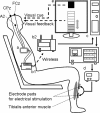Event related desynchronization-modulated functional electrical stimulation system for stroke rehabilitation: a feasibility study
- PMID: 22897888
- PMCID: PMC3481429
- DOI: 10.1186/1743-0003-9-56
Event related desynchronization-modulated functional electrical stimulation system for stroke rehabilitation: a feasibility study
Abstract
Background: We developed an electroencephalogram-based brain computer interface system to modulate functional electrical stimulation (FES) to the affected tibialis anterior muscle in a stroke patient. The intensity of FES current increased in a stepwise manner when the event-related desynchronization (ERD) reflecting motor intent was continuously detected from the primary cortical motor area.
Methods: We tested the feasibility of the ERD-modulated FES system in comparison with FES without ERD modulation. The stroke patient who presented with severe hemiparesis attempted to perform dorsiflexion of the paralyzed ankle during which FES was applied either with or without ERD modulation.
Results: After 20 minutes of training, the range of movement at the ankle joint and the electromyography amplitude of the affected tibialis anterior muscle were significantly increased following the ERD-modulated FES compared with the FES alone.
Conclusions: The proposed rehabilitation technique using ERD-modulated FES for stroke patients was feasible. The system holds potentials to improve the limb function and to benefit stroke patients.
Figures



Similar articles
-
Brain-controlled functional electrical stimulation therapy for gait rehabilitation after stroke: a safety study.J Neuroeng Rehabil. 2015 Jul 11;12:57. doi: 10.1186/s12984-015-0050-4. J Neuroeng Rehabil. 2015. PMID: 26162751 Free PMC article.
-
A new therapeutic application of brain-machine interface (BMI) training followed by hybrid assistive neuromuscular dynamic stimulation (HANDS) therapy for patients with severe hemiparetic stroke: A proof of concept study.Restor Neurol Neurosci. 2016 Sep 21;34(5):789-97. doi: 10.3233/RNN-160652. Restor Neurol Neurosci. 2016. PMID: 27589505
-
Does feedback based on FES-evoked nociceptive withdrawal reflex condition event-related desynchronization? An exploratory study with brain-computer interfaces.Biomed Phys Eng Express. 2021 Sep 3;7(6). doi: 10.1088/2057-1976/ac2077. Biomed Phys Eng Express. 2021. PMID: 34431480
-
Neurorehabilitation with new functional electrical stimulation for hemiparetic upper extremity in stroke patients.J Nippon Med Sch. 2008 Feb;75(1):4-14. doi: 10.1272/jnms.75.4. J Nippon Med Sch. 2008. PMID: 18360073 Review.
-
Novel patterns of functional electrical stimulation have an immediate effect on dorsiflexor muscle function during gait for people poststroke.Phys Ther. 2010 Jan;90(1):55-66. doi: 10.2522/ptj.20090140. Epub 2009 Nov 19. Phys Ther. 2010. PMID: 19926681 Free PMC article. Review.
Cited by
-
Development of a flickering action video based steady state visual evoked potential triggered brain computer interface-functional electrical stimulation for a rehabilitative action observation game.Technol Health Care. 2020;28(S1):509-519. doi: 10.3233/THC-209051. Technol Health Care. 2020. PMID: 32364183 Free PMC article.
-
Review of devices used in neuromuscular electrical stimulation for stroke rehabilitation.Med Devices (Auckl). 2017 Aug 24;10:207-213. doi: 10.2147/MDER.S123464. eCollection 2017. Med Devices (Auckl). 2017. PMID: 28883745 Free PMC article. Review.
-
Brain-Computer Interface-Controlled Exoskeletons in Clinical Neurorehabilitation: Ready or Not?Neurorehabil Neural Repair. 2022 Dec;36(12):747-756. doi: 10.1177/15459683221138751. Epub 2022 Nov 25. Neurorehabil Neural Repair. 2022. PMID: 36426541 Free PMC article. Review.
-
A portable, programmable, multichannel stimulator with high compliance voltage for noninvasive neural stimulation of motor and sensory nerves in humans.Sci Rep. 2023 Mar 1;13(1):3469. doi: 10.1038/s41598-023-30545-8. Sci Rep. 2023. PMID: 36859464 Free PMC article.
-
Differences in Rheobase and Chronaxie between the Paretic and Non-Paretic Sides of Hemiplegic Stroke Patients: a Pilot Study.J Phys Ther Sci. 2013 Jun;25(6):717-9. doi: 10.1589/jpts.25.717. Epub 2013 Jul 23. J Phys Ther Sci. 2013. PMID: 24259837 Free PMC article.
References
-
- Kannenberg A, Mileusnic M. Functional electrical stimulation and EMG triggered electrotherapy in motor rehabilitation after stroke: An analysis of scientific literature. Literature Survey, Otto Bock HealthCare. 2009;1:65.
-
- de Kroon JR, Ijzerman MJ, Chae J, Lankhorst GJ, Zilvold G. Relation between stimulation characteristics and clinical outcome in studies using electrical stimulation to improve motor control of the upper extremity in stroke. J Rehabil Med. 2005;37:65–74. doi: 10.1080/16501970410024190. - DOI - PubMed
Publication types
MeSH terms
LinkOut - more resources
Full Text Sources
Medical
Miscellaneous

